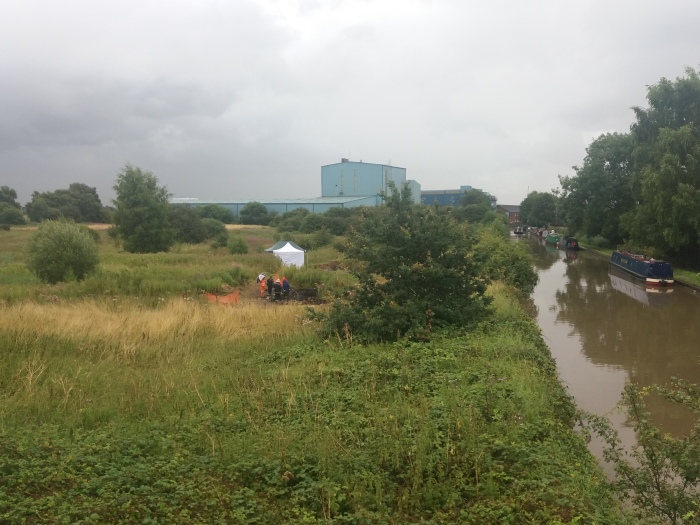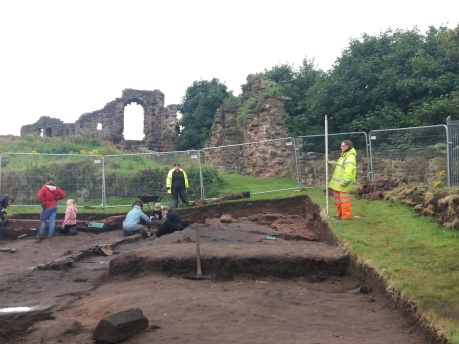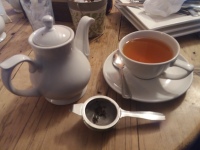
Ollershaw Law Salt Works excavations, Northwich, July 2017
I was fortunate to be able to take part in the 2017 Day of Archaeology. The future of this ‘online archaeology reality documentary’, which has been running for six years, is in doubt. If you want to help continue the project contact the organisers via the website, where you will find my original blog along with over 2000 other posts from around the world. The web address is:
http://www.dayofarchaeology.com/
This year’s Day of Archaeology happened to fall on the 28th July when I found myself juggling the three strands of my working life: community, commercial and academic archaeology. I realise that I have been very lucky to be paid to do a job I really enjoy for more than 29 years, and perhaps even to make a small contribution to better understanding a small part of our shared past. That though doesn’t make these kind of days any less hectic, nor stop me from longing for the more simple days of just doing field and project work.
The morning was occupied by a phone call from a client about a project involving oral histories and a popular publication. Then it was on to the last changes to a grant application that’s taken all year to put together, with no certainty of success. Finally, I escaped the archaeology office, in the basement (where else) of one of the buildings at the University of Salford, to visit our two community archaeology sites we have been running this week: the Ollershaw Lane salt works site and Halton Castle, both in Cheshire. This of course meant braving the clogged and roadwors-strewn motorway system between Manchester and Northwich – not so much a Northern Powerhouse, more one long traffic queue.
We are excavating the Ollershaw Lane Salt Works site as part of the Saltscape landscape partnership project. Very few 19th century open-pan salt making sites have been excavated and like many examples in Cheshire this one was short-lived (50 years tops) and judging by the map evidence the layout changed from decade to decade. I’m always surprised how quickly documentary material is lost. It’s not just a particular problem of the paperless internet age. This was a works that ran for 50 years from the 1870s to the 1920s yet there are no business records nor photos left as far as we know. With just a few newspaper and directory mentions archaeology is our only way left of uncovering the site’s history. This lack of documentary evidence for the industrial period is always something that astonishes our volunteers, in this case even more so as the Lion Salt Woks, its buildings now a museum and its family business records intact mostly, lies opposite the site on the other side of the Trent and Mersey Canal. Our Saltscape volunteers, most of whom had never done archaeology before, have learnt over the last 12 months that the thrill of new discoveries is not just about how old a site is. The process of archaeological fieldwork has got them thinking and asking questions: why is this building here? How does it relate to the canal arm? What was its function? When was the canal arm filled? It doesn’t take long for the hidden archaeologist to emerge in each of them, with the help and training of our Salford University professional supervisors, Mandy and Sarah-Jayne.

Halton Castle excavations, July 2017
Halton Castle lies a few kilometers north of the Ollershaw Lane site, perched atop a sandstone hill in Runcorn, overlooking the Mersey estuary. This is the second season of work so we already have a pool of experienced volunteers from the 2015 excavation. On this site we are working on behalf of the Norton Priory Museum Trust, who run the site, exploring the activity within the outer bailey of the castle. Last time we discovered, unexpectedly, two skeletons dating to the 16th or early 17th centuries. Bodies in castles, especially outside a chapel, are very rare and so we are back this season to discover more about their context. The volunteers are enthusiastic, old relationships have been renewed, fresh ones made, and despite the showery weather this week they have all been excited by what they have uncovered. That does not include any more skeletons but it does encompass three mysterious rectangular rock-cut pits. There are also more rock-cut circular post pits to add to those from 2015, perhaps suggesting the presence of a timber aisled building. For old and new volunteers alike the excitement of discovery is palpable, and for some there is still the astonishment of being able to learn archaeology as a discipline first hand. And I even got the chance to help out with barrowing away the spoil, much to the amusement or was that amazement of my professional team of Sarah and Kirsty who did all the hard work of setting up and running the site.
 I stopped off at a motorway services on the way back home for a cup of tea (really must get round to writing that archaeology of tea drinking and the tea industry at some stage). It’s a chance for a swift review of my work emails and an opportunity to post some more Day of Archaeology tweets. Yet why does this well-known brand of coffee shop insist on presenting me with a pot of boiling water with the teabag on the OUTSIDE? Just one more mystery to add to my day of archaeology.
I stopped off at a motorway services on the way back home for a cup of tea (really must get round to writing that archaeology of tea drinking and the tea industry at some stage). It’s a chance for a swift review of my work emails and an opportunity to post some more Day of Archaeology tweets. Yet why does this well-known brand of coffee shop insist on presenting me with a pot of boiling water with the teabag on the OUTSIDE? Just one more mystery to add to my day of archaeology.


